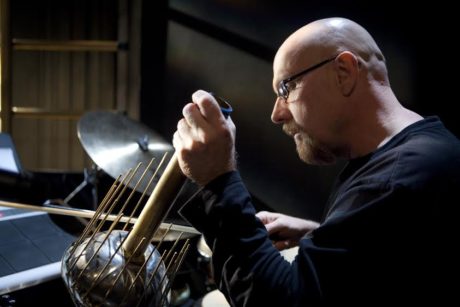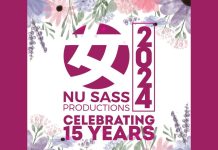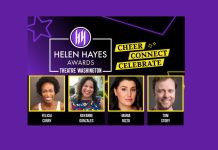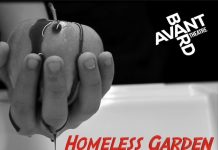For five nights only, world renowned percussionist Tom Teasley is performing an original composition set to Fritz Lang’s 1927 sci-fi film Metropolis. I saw the first performance at Constellation Theatre Company last night and was gobsmacked by his performance and inspired to ask Tom some follow up questions.
Nicole: Gottfried Huppertz’ original score to Metropolis was written in 1927 for a large classical orchestra and was inspired by German composers like Richard Wagner and Richard Strauss. Since then, a wide variety of scores have been composed to accompany the movie, including a pop album in 1984 with music by Loverboy, Adam Ant and Freddie Mercury. Your score is global percussion. What is it about Metropolis that lends itself to such a wide variety of music styles?

Tom: The visuals alone provide a plethora of aural references. I think the nature of the percussion is especially interesting in referencing the motion on machine gears turning. With all four limbs I am creating interlocking patterns using acoustic percussion, electronic percussion, keyboards and DJ technology. Then there is the topic of class struggle, the balance between the hands, brain and the heart, which offer an emotional platform for expression as well.
Did you listen to the original Gottfried Huppertz score before working on your score? If so, did it inform you in any way? If not, did you avoid it on purpose?
I did listen to it but it wasn’t a big influence. While I respect and admire his original score I wanted to capture something that is more reflective of our current 2016 sound library. I am also very intrigued with combining the acoustic instruments with the electronic sounds as I think it’s a compelling reference to the humans working with the machines in the film. I also find the choreography in the film during the workers section very compelling underscored with tightly synced rhythms from the percussion.
Take us through the steps involved in creating a piece this. Do you start by just watching the movie and getting a feel for it?
I start by watching the film with just one instrument, usually a djembe. I develop a feel for the emotional content, large sections, action scenes and choreography that I want to underscore. I then slowly add instruments so that the musical content takes precedence over the exotic sounds. The last element to be added are specific loops or prerecorded underscoring to accompany sections.
You mentioned at the show tonight that there is a core of the music that will remain the same from show to show but also a heavy improvisational element each time you play the piece. Can you talk a bit about that?
I look at these live film scores from a jazz player perspective. That is to say the film is a “composition” with a form that needs to be adhered to just as a jazz standard has form and chord changes. This broad structure allows me to be “in the moment” with regards to some of the specifics that I perform. I am tapping into what I played in a prior moment, the energy I am feeling from the audience and other factors. Ideally an audience member could see/hear all five performances and know there are defined sections and that there is room for interpretation in each performance that will be different. That is what makes my performance with film different from a composer that is presenting a completely composed presentation.
You talked tonight about wanting to combine the sounds of traditional percussion instruments with new electronic instruments. Tell us a little bit about why this works so well for a piece like this or for percussion in general.
I like to combine percussion traditions from different parts of the world. Last night I demonstrated techniques on the Irish Bodhran from ancient Mesopotamia, India, South Italy, Spain and more. I do that type of “cross pollination” on all of my traditional percussion instruments. So I’m creating a pan cultural approach to these instruments that are thousands of years old. I find it interesting to combine these ancient traditions with music technology; and especially sounds found in popular music. I want my work to respect and reflect all traditions ancient to futuristic!
You really perform with your entire being: Your body, your voice, you are all in! Your body seems to be coaxing sounds out of certain instruments by swaying or torking it in a certain way and you mentioned that even your shoes were special instruments. Can you discuss some of the instruments you used tonight?

Well, my performances; good, bad or indifferent are a “full on” commitment that is reflected at the very core of my being. That is outwardly manifested
in my body language that provides an emotive and physical nuance from the instruments.
My acoustic rig consists of a djembe, bongos, cymbals, variety of bells, blocks and a cajone. Also I’m playing bamboo flute, melodica, and an aquasonic. Aquasonic is a globe with spokes of different length that I bow with a cello bow. The electronics are a keyboard that I’m triggering violin sounds and DJ scratching sounds from, a Kaoss pad which is really used by DJs more than instrumentalists. The HandSonic is a hand drum synthesizer that allows me to create and sample a wide variety of percussion, hip-hop sounds and other effects. I have that connected to a looping pedal that allows me to record my performances in real time and play back to create a virtual ensemble.
Who are some percussionists who inspire and influence you? You mentioned Miles Davis’ work. I was very much reminded of Grateful Dead percussionist Mickey Hart when hearing you play. I also recently got to see The Roots play with Jeremy Ellis and his use of electronic instruments also struck me as similar to your work tonight.
All the people you mentioned would count as influences and inspirations. In addition, I have had several mentors; jazz greats Joe Morello and Ed Thigpen, world percussionists, Glen Velez, Zakir Hussain. I now have several students that are traveling the world and making an impact globally, Sam Shahin, and Kush Abadey are two prominent ones. Non-percussion influences on Metropolis are the classical, electronic pioneer composers Edgar Varese and Karlheinz Stockhausen.
Tell us about your work as a cultural envoy with the State Department. Where did you go, what did you do and how did it inform you as a musician and as a person?
My work as a cultural envoy is among the most important and rewarding work that I do. I have traveled extensively to the Middle East including Bahrain, Saudi Arabia, Iraq, Israel and the West Bank. That work has recently taken me to South Korea, New Zealand and Samoa. My task is to teach some master-classes and collaborate with indigenous musicians. I am constantly reminded that we all so much more alike than we are different. Many times during a very short rehearsal with musicians that don’t share a common language I am constantly reminded that music can express that which words cannot. I have expanded this concept to work with healing sound for guided meditation used with doctors and therapists as well as sound healing sessions and community drumming. This holistic direction will be taking more of my focus in the future.
Tell us a bit about your background. How did you get into percussion? What is your “philosophy” as a musician.
As an elementary school student I heard the crack of a snare drum and it was life altering. I started playing professionally when I was in middle school. I later went to Peabody Conservatory to study orchestral percussion. Soon after graduating I began touring to New Orleans. It was there that I first experienced a variety of world cultures through the ears and eyes of Americana. That inspired me to my study with master drummers from Africa, India and the Middle East. I have expanded on the traditional American Jazz tradition of combining African rhythm and culture with European harmony to include influences from those aforementioned traditions I studied. As I began to tour those areas and know the populations personally my firm belief that we are one heart beat as a world community expressed though rhythm became more profound. We are at a pivotal time in our world where the divisiveness is extreme. It is more important than ever that artists take a lead in reflecting out true light as a global population and filtering out the dark with positive sonic vibrations of goodwill and peace.
More info on my projects and work is available on my site www.tomteasley.com
Running Time: 75 minutes with no intermission. Performance includes a Q and A session with Tom Teasley following his performance.
Metropolis (with original score by Tom Teasley) performs through November 19, 2016 at Constellation Theatre Company performing at Source – 1835 14th Street NW, in Washington, DC. Tickets can be purchased by calling (202) 204-7741 or online.
Watch Metropolis here:
https://youtu.be/nmpDD0X8p9g






Thank you Nicole for your interest in my work. Your support will inspire me to dig deeper.
Peace,
Tom